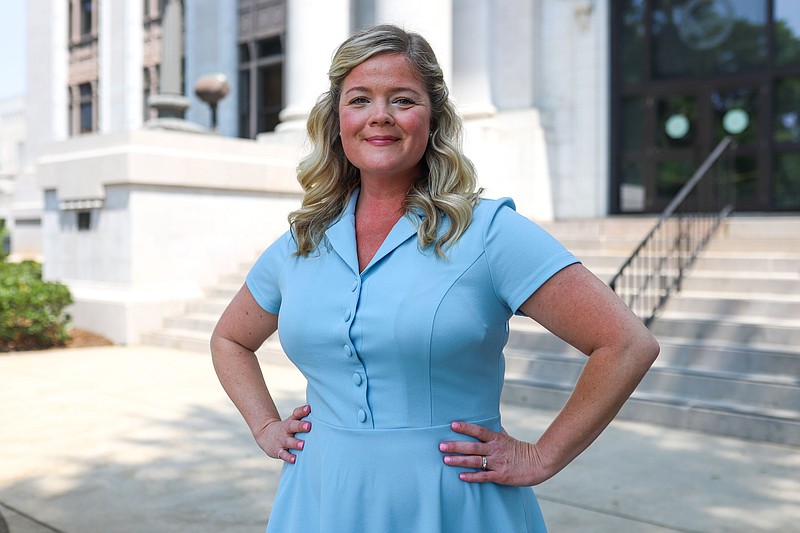Hamilton County is turning to data to help address the opioid crisis.
Jennifer Baggett, a longtime analyst with the Chattanooga Police Department, started this month as a county data analyst focusing on overdoses, homelessness and crime. Her job will include producing a monthly report, called Hamilton Counted, that will give updates on those issues and others in the county. The first report is set to go out in mid-July.
The position will initially be funded by money Hamilton County received from settlements in opioid-related lawsuits.
Last week, Baggett sat down with the Chattanooga Times Free Press for an interview, which has been edited for length and clarity.
Q: Tell me about your background working at the city of Chattanooga and how you ended up in this new job.
A: I started with the city of Chattanooga right out of college and was an employee for 17 years, the last eight at the Chattanooga Police Department. And out of those eight, the last four spent as the sole analyst for the Organized Crime Unit, focusing on drug overdose data and helping investigators. I managed our gang validation list, I did gun link analysis charts, and I managed the ShotSpotter database for the gun team. It's the best way I know how to help from a civilian standpoint.
I was fortunate enough to be one of the first analysts that started the crime analysis unit. The Police Department kind of didn't know they had a crime analysis unit until we started putting out products — they didn't know what they didn't know. They immediately started realizing, hey, we have people in our department that can do data and direct us on where to go and when to go. I learned very quickly that the way I can help the most is to pull as much data as possible and analyze it and put it out to them in a way that's succinct and concise.
(READ MORE: Q&A: Chattanooga Police Capt. Heather Williams on new Special Ops role)
Q: What are some examples of ways data informs police work?
A: For example, one police officer shows up and does his call. He closes out his call, and the next day another officer shows up to the same area. They do their call and they're done. They're not cross-referencing that there's certain crime again in the same area. So we were able to basically aggregate all that data and analyze it and put it together — the who, what, when, where, why, the M.O. (modus operandi). Any special notes regarding their clothing, were there surveillance cameras around, all of that stuff is extremely helpful for everyday tactical purposes for patrol officers.
For investigators, I was able to keep track of the people who kept overdosing. I called them our repeaters. That was extremely helpful because it allowed us to send certain names based on their historical drug use to the (Hamilton County) Coalition and recovery court so they could reach out and offer them help and resources.
I started tracking overdoses on my own, it wasn't part of my regular duties. I kept seeing all of these drug equipment violations, and then I started seeing overdose data come through. I officially got asked by the narcotics unit in 2021 because they were coming in faster than the narcotics investigators could keep up with. They especially liked phone numbers and associates, so I made sure that I included that, and we had a shared log to where any investigator could search all that data.
Q: What interested you about this new position?
A: It's basically, to me, about using your skill set to fill a void, to fill a gap, to fill a need, and the county has a need right now.
The Hamilton County Sheriff's Office has a crime analysis unit, but there's only two of them and they have to do crime for the whole county. This role will allow me to focus on just this, and free up their time hopefully doing other things for their investigators and patrol. I'm sure I'll be collaborating with them, and I look forward to that.
Q: What have you been doing in this new role so far?
A: One meeting I got to go to in person was the (Health Department) addiction and dependency committee. That was eye-opening. I was able to meet everyone there for the first time, understand what the committee does. I also have been on a Zoom meeting regarding housing needs in Chattanooga, and I've been to a Narcan meeting.
I'm working on collaborating with some folks on different projects coming up soon. I'm going to focus on overdose data in general, and also homeless data, and I imagine a little bit of crime. I'll also be managing some mental health data. I'll be focusing on the social harms to Hamilton County more than, say, violent crime. That's what Mayor (Weston) Wamp had said during his interviews regarding this position.
(READ MORE: Drug related deaths spike in Hamilton County)
Q: What is your plan for the Hamilton Counted report?
A: I definitely want to include overdoses. I think it's very underrated in the community. I want their eyes to be more open. I want this report to be detailed enough to where my higher-ups and decision-makers can use it as a guide. But I also want it to be easy enough to read for the layperson, a one-stop shop that houses everything we need to know about our community in a snapshot over a month. That's kind of my vision.
The county has so many groups and resources and nonprofits. I don't want to say they're silos, but we have EMS data, we have hospital data, we have crime data, but they're all overdose data. So I would like to take all of those and aggregate it into one easily digestible way to understand what's going on. Same thing with the homeless data and anything the mayor would like to see or what he thinks the community should know about — I'll go get the data.
Q: How can data help inform elected officials or decision-makers?
A: I think there's a misconception among people, when they hear "data analyst," that it's just numbers, statistics, hard formulas, and it's not. Places are data, people are data. Anything that can be put into a centralized location to be tracked and measured, that's data.
So the overdose stats are going to drive decisions for the abatement council in what we're doing with the abatement money that Hamilton County has been allotted. They're not going to know where to put the resources if they don't have data.
You want to look at things as a whole, not just numbers. You need some context. So with homeless data, I'm not very familiar with it, but I imagine some things that would be helpful are encampment areas, mental health, also crime. Same thing with overdoses — are these folks also committing crimes? All of that goes into these types of social harms.
(READ MORE: Hamilton County expects to receive $1.5 million for opioid abatement, remediation)
Q: What are some trends in overdoses you noticed in your time at the Police Department?
A: I watched fentanyl literally enter our community through data, and it was very scary. I didn't even know how to pronounce it at first. I had no clue what it was going to be like. I was reading every single day, all these police reports, all these overdose reports, it was heroin, heroin, heroin, meth and heroin, and then it was fading out to fentanyl, heroin, heroin, fentanyl, fentanyl, and then hardly any heroin and just fentanyl, fentanyl, fentanyl.
Q: How much county data will be made public?
A: Working in the Police Department, most of my products went to police officers and investigators and our command staff where everything is confidential and for law enforcement purposes only.
In this role, I have a feeling more stuff's going to be made public and published. Obviously, we have to keep in mind the data integrity of our victims, also of our suspects. I'll be finding out how much they want to reveal. Do they want to just reveal a ZIP code and show areas that have a lot of overdoses? Do they want to get down to the street level? That will be all things that I learned as I go. I will have as much data as possible, and then I'll have to scale it back to keep the data integrity intact.
Contact Ellen Gerst at egerst@timesfreepress.com or 423-757-6319.

